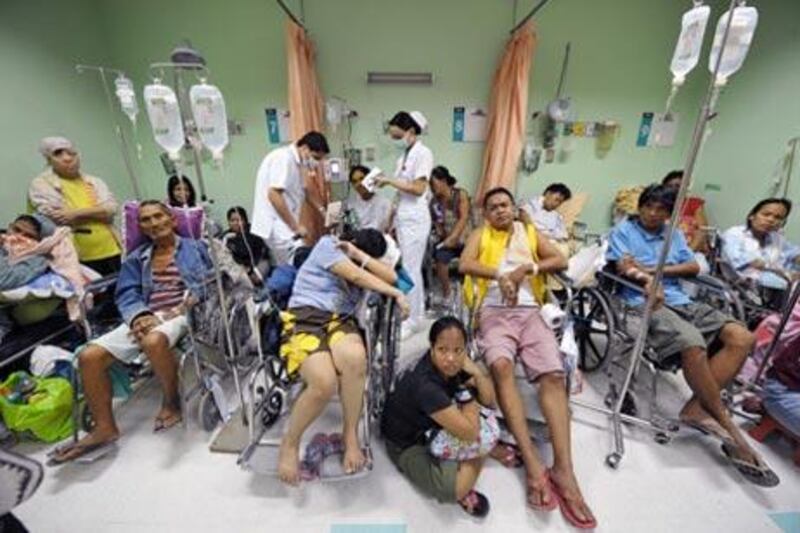MANILA // Doctors from the World Health Organisation began arriving in Manila yesterday to help local authorities battle an outbreak of leptospirosis, a deadly byproduct of the recent flooding in the Philippine capital and surrounding provinces. Nearly four weeks since Tropical Storm Ketsana flooded 80 per cent of the capital, many parts of the metropolis of 14 million people are still inundated with water that is not expected to go down for three to six months.
What is worrying health authorities is a second outbreak of the disease, which had killed 162 people as of yesterday. The health secretary, Francisco Duque, said a request to the WHO was made last week for help to curb the spread of leptospirosis, a bacteria carried in water contaminated with the urine of animals, rats in particular. "While the number of cases has peaked, we fear there could be a second outbreak as many parts of the capital are still flooded," he said.
The first of a four-person team of experts arrived in Manila from the WHO's Global Outbreak Alert and Response Network. The others are expected to arrive today. Three of the team are epidemiologists and the other an expert on leptospirosis. The network was set up in 2000 by the WHO and comprises experts from 140 global institutions and networks "who pool human and technical resources for the rapid identification, confirmation and response to outbreaks of international importance", according to a positing on its website.
"We need help from experts as this is one of the biggest outbreaks not just in the Philippines, but in the world," Eric Tayag, head of the government's National Epidemiological Centre, said. Since the storm hit on September 26 more than 2,089 people have been treated for the bacterial infection in Manila and surrounding provinces and 162 people have died - more than five times the number of leptosipirosis deaths in the entire country last year , according to the epidemiology centre.
In 2008 there were 246 cases nationwide and 31 deaths from leptospirosis. "No one was prepared for this type of storm let alone the massive spike in cases of leptospirosis," said Eumelia Salva, head of public health services at Manila's San Lazaro Hospital. "It was one to two weeks after the storm that we noticed a major spike in admissions and before we knew it we were over whelmed with cases," Dr Salva said.
The 500-bed, 413-year-old hospital, the main referral hospital for infectious diseases in Manila, was forced to have leptospirosis patients share beds. "Test kits ran out as we only keep so many in stock for the wet season," Dr Salva said. She said: "The problem we as doctors face is to try and isolate the strain of leptospirosis that killed so many people. That is why the WHO has been called in.
"For the first time we noticed many of the patients that died had severe haemorrhaging - we had not seen that before. "That is why we need to isolate this particular strain. There are many strains to leptospirosis and this one was particularly deadly." The outbreak has added to the many problems faced by the Philippines after back-to-back storms killed more than 900 people and devastated Manila and large parts of northern Luzon province.
To prevent the infection from spreading further, government health workers have given antibiotics to 1.3 million people in the affected areas of the capital and they have begun a public awareness campaign. Peter Cordingley, the WHO's spokesman for the western Pacific region, said many communities remain flooded and the number of infections could continue to grow, though the number of fresh cases reported in government hospitals has begun to drop as waters recede in some areas.
Dr Tayag said the main danger now was a second outbreak in Manila. Leptospirosis is spread through exposed cuts and bruises. The disease can cause high fever, headache, sore muscles and vomiting. In extreme cases, it can lead to kidney failure and internal bleeding that can cause death. Albert Casis, a 19-year-old tricycle taxi driver from Pasig avoids going through flood water because he knows that it could be contaminated with leptospirosis. "I saw the warnings about the disease on TV after the storm," he said.
In parts of Pasig where water is still ankle- to knee-deep, only a few people wear wellingtons, most wear only traditional flip-flops. Children still play in the water while their parents look on oblivious to the potential health problems. Nerio Taculod, 45, part of the Pasig City mayor's personal security guard, said there had been several cases since Ketsana in the barangay. He noted many of the poor could not afford wellingtons, but tricycle taxi drivers and vendors selling food and goods from carts still needed to go into flooded areas to make living.
The father of five said: "I've warned my children not to go into flooded areas, and we check every day to make sure that they have no cuts on their feet." @Email:foreign.desk@thenational.ae





